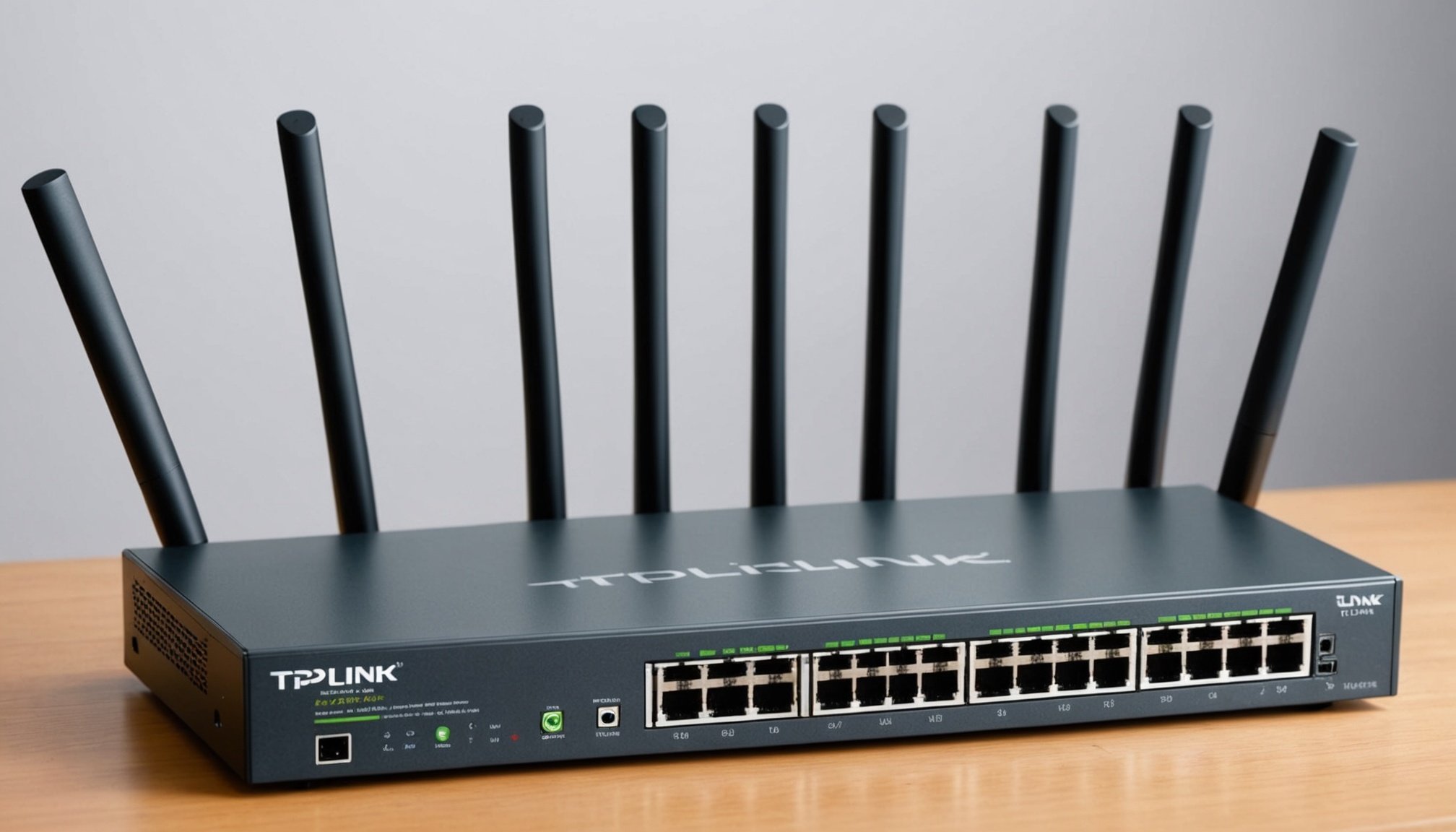Unleash Blazing Speeds: The Ultimate Guide to Configuring Your TP-Link TL-SX1008 10GbE Switch
Why You Need a 10GbE Switch in Your Network
In today’s fast-paced digital world, the demand for high-speed network connections is higher than ever. Whether you’re a gamer, a small business owner, or simply someone who values seamless data transfer, a 10GbE (10-Gigabit Ethernet) switch is an essential component of your network infrastructure. The TP-Link TL-SX1008 is one such device that promises to unlock the full potential of your 10G/Multi-Gig bandwidth and devices.
Key Features of the TP-Link TL-SX1008
Before diving into the configuration, it’s crucial to understand the key features that make the TL-SX1008 a powerhouse in the world of networking.
This might interest you : Mastering Multi-Room Audio: Sonos Arc & Google Assistant Setup Guide
Eight 10 Gbps Ports
The TL-SX1008 boasts eight 10-Gigabit ports, providing up to 160 Gbps of switching capacity. This is ideal for connecting high-bandwidth devices such as 10G NAS, servers, gaming computers, and WiFi 6 access points[1].
Lightning-Fast Connections
This switch is designed to deliver lightning-fast connections, making it perfect for various scenarios including business and home offices, workstations, LAN parties, and home entertainment. It supports auto-negotiation for 5-speed connections (100Mbps/1G/2.5G/5G/10G), ensuring optimal performance for all your devices[1].
Also to read : Upgrade your business with reliable refurbished servers
Robust Design
The durable metal casing and heat dissipating design of the TL-SX1008 ensure a wide operating temperature range (0–50 °C), making it suitable for any work or home environment. The intelligent cooling algorithm maximizes performance while minimizing noise[1].
Setting Up Your TP-Link TL-SX1008
Configuring your TL-SX1008 is relatively straightforward, thanks to its plug-and-play design. Here’s a step-by-step guide to get you started:
Physical Installation
- Mounting Options: The TL-SX1008 offers flexible deployment options, allowing you to place it on a desktop or mount it in a rack. This versatility makes it easy to integrate into your existing setup[1].
- Connecting Devices: Connect your devices to the 10G ports. Ensure that you are using compatible cables; for 10G connections, Cat6a or higher rated cables are recommended[1].
Powering On
- Power Supply: Plug in the power cord and turn on the switch. The LED indicators will light up to show the system power and link/activity status for each port[1].
Initial Configuration
- Auto-Negotiation: The TL-SX1008 supports auto-negotiation, which automatically senses the link speeds and adjusts for compatibility and optimal performance. This feature eliminates the need for manual configuration of port speeds[1].
- Auto MDI/MDIX: This feature eliminates the need for crossover cables, making the setup process even simpler[1].
Optimizing Traffic with VLAN and QoS
To get the most out of your TL-SX1008, you need to optimize traffic flow using VLAN (Virtual Local Area Network) and QoS (Quality of Service) configurations.
VLAN Configuration
- Logical Grouping: VLANs help reduce the broadcast domain and enhance security by logically grouping devices. Identify the devices and applications that require separation and assign them VLAN IDs using the switch management interface[5].
- Example: If you have a small office with different departments, you can create separate VLANs for each department to improve security and reduce network congestion.
QoS Configuration
- Priority Queues: QoS allows you to prioritize traffic based on different criteria such as application type or user group. The TL-SX1008 supports 802.1p/DSCP QoS, enabling you to set up priority queues to ensure critical applications receive the necessary bandwidth[1].
- Example: For gamers, you can prioritize gaming traffic to reduce latency and ensure a smooth gaming experience.
Troubleshooting Common Issues
Even with the best setup, issues can arise. Here are some steps to troubleshoot common problems with your TL-SX1008:
Evaluate Physical Connections
- Cable Integrity: Ensure all cables are fully functional and meet the required standards (Cat6a or higher for 10G). Damaged or non-compliant cables can significantly impact performance[5].
Confirm Port Configuration
- Auto-Negotiation: Make sure auto-negotiation is enabled or set the port speeds manually if necessary. Ensure all switch ports are arranged as needed for the end devices to be connected[5].
Examine Device Support
- 10G Capability: Verify that all devices connected to the switch support 10G speeds. Incompatible devices can lead to connectivity issues[5].
Maintain Firmware
- Firmware Updates: Regularly check for firmware updates and install the latest version to resolve any software-related issues[5].
Enhancing Performance with the Right Cables and Devices
To maximize the performance of your TL-SX1008, it’s crucial to use the right cables and devices.
Upgrading Cables
- From Cat5 to Cat6a: Upgrading from older Ethernet cables (Cat5 or Cat5e) to Cat6 or Cat6a can significantly improve data transfer rates and reduce signal interference[5].
- Example: If you’re using Cat5e cables, switching to Cat6a cables can support speeds up to 10 Gbps over longer distances.
Power over Ethernet (PoE) Devices
- PoE+ and PoE++: If you have devices like IP cameras or wireless access points that require power, ensure your switch supports PoE+ (802.3at) or PoE++ (802.3bt) standards. This can help meet higher power demands efficiently[5].
Practical Insights and Actionable Advice
Here are some practical tips to get the most out of your TP-Link TL-SX1008:
Use the Right Hardware
- Compatible Devices: Ensure all devices connected to the switch are compatible with 10G speeds. This includes using 10G-capable network cards and WiFi 6 access points[1].
Optimize Your Network
- Segment Your Network: Use VLANs to segment your network and reduce broadcast domains. This can improve security and performance by isolating different parts of your network[5].
Regular Maintenance
- Firmware Updates: Regularly update the firmware of your switch to ensure you have the latest features and bug fixes.
- Cable Management: Properly label and manage your cables to avoid confusion and ensure easy troubleshooting.
The TP-Link TL-SX1008 is a powerful tool for anyone looking to unleash blazing speeds in their network. With its plug-and-play design, robust features, and high-performance capabilities, it is an ideal choice for both home and business environments.
Key Takeaways
- High-Speed Connections: The TL-SX1008 offers eight 10-Gigabit ports, providing up to 160 Gbps of switching capacity.
- Easy Deployment: The switch features a plug-and-play design with auto-negotiation and auto MDI/MDIX, making setup straightforward.
- Optimal Performance: Use VLAN and QoS configurations to optimize traffic flow and ensure critical applications receive the necessary bandwidth.
- Regular Maintenance: Keep your firmware updated and use the right cables and devices to maximize performance.
By following this guide, you can fully leverage the capabilities of your TP-Link TL-SX1008 and enjoy lightning-fast connections that enhance your overall networking experience.
Detailed Specifications Table
Here is a detailed table of the key specifications of the TP-Link TL-SX1008:
| Feature | Description |
|---|---|
| Ports | 8 x 100Mbps/1Gbps/2.5Gbps/5Gbps/10Gbps Ports, Auto-Negotiation, Auto-MDI/MDIX |
| Switching Capacity | 160 Gbps |
| Packet Forwarding Rate | 119.0 Mpps |
| MAC Address Table | 32 K |
| Packet Buffer Memory | 2 Mb |
| Jumbo Frame | 10 KB |
| Fan Quantity | 1 (Intelligent fan speed adjustment) |
| External Power Supply | 100–240 VAC, 50/60 Hz, 0.8A |
| LED Indicator | System Power: 1, Link/Act Indicators: 8 |
| Dimensions | 11.6 x 7.1 x 1.7 in (294 x 180 x 44 mm) |
| Max Power Consumption | 31.2 W |
| Operating Temperature | 0–50 °C (32–122 °F) |
| Storage Temperature | -40–70 °C (-40–158 °F) |
| Operating Humidity | 10–90% RH non-condensing |
| Storage Humidity | 5–90% RH non-condensing |
Troubleshooting Checklist
Here is a detailed checklist to help you troubleshoot common issues with your TL-SX1008:
-
Evaluate Physical Connections
-
Ensure all cables are fully functional.
-
Check if cables meet the required standards (Cat6a or higher for 10G).
-
Replace damaged or non-compliant cables.
-
Confirm Port Configuration
-
Ensure auto-negotiation is enabled or set port speeds manually if necessary.
-
Arrange switch ports as needed for the end devices.
-
Examine Device Support
-
Verify that all devices connected support 10G speeds.
-
Ensure network cards and WiFi 6 access points are 10G-capable.
-
Maintain Firmware
-
Regularly check for firmware updates.
-
Install the latest firmware version to resolve software-related issues.
-
Conduct Network Check
-
Deploy ACLs and IP and VLAN settings to resolve communication issues.
-
Isolate and troubleshoot by adding devices one by one to locate the problem.
By following these steps and using the right hardware and configurations, you can ensure your TP-Link TL-SX1008 operates at its best, providing you with the high-speed connections you need for a seamless networking experience.











